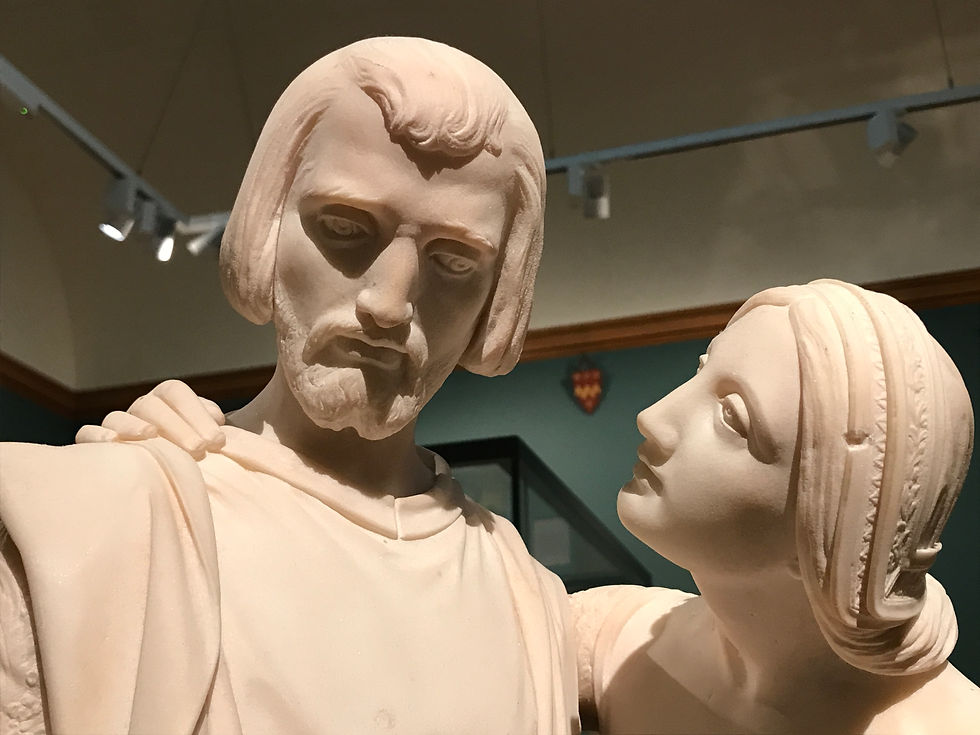Carving out a reputation: Pio Fedi, a 19th century Florentine sculptor
- Dawn Cumming
- Feb 1, 2023
- 3 min read
I first encountered the name of Pio Fedi not through one of his many excellent sculptures but whilst I was doing research for my book: ‘In Search of Annalena A Life of Tragedy and Triumph in Renaissance Florence’.
Annalena Malatesta (the subject of my book) founded a convent in the middle of the 15th century, known as the Monastero di San Vincenzo or the Annalena convent. The convent was located along the Via Romana in the Oltrarno (area south of the river Arno) in Florence. Around the same time and within the vicinity of the Annalena convent (in the Via dei Serragli) another convent, that of Santa Chiara, was founded whose church can still be seen today, although much altered. In my book I discuss in detail the reconstructed chancel chapel of Santa Chiara which is now in the Victoria and Albert Museum in London and the only Italian Renaissance chapel that can be seen outside of Italy. The 19th century sculptor Pio Fedi purchased the former convent church (89 Via dei Serragli) in 1842 and made it his studio. The chapel was originally located in the church of Santa Chiara and appears to have passed into the hands of an unnamed owner who sold it to John Charles Robinson, the first curator of the art collections at the South Kensington Museum, London (now the V&A) in 1860. Robinson paid £386 for the High altar chapel and High altarpiece. At the time my interest of course was directed at a comparative study of the Santa Chiara chapel in relation to the Annalena convent church. However, this was the first time that I had heard of the name of Pio Fede.
Pio Fedi (1816-1892) was a classical sculptor in the years when Florence was the capital of the new kingdom of Italy (from 1865-71) and he produced many great works including his masterpiece ‘the Rape of Polyxena’, 1865 which can be seen on the left side of the open air gallery of the Loggia dei Lanzi in the Piazza della Signoria in Florence. In this outstanding 4-figure group sculpture executed from a single block of marble, we encounter an embodiment of tangled limbs and despair. Polyxena (daughter of the King of Troy) is being wrenched from her pleading mother and murdered brother to be sacrificed on the tomb of Achilles after the fall of Troy. Following the unveiling of this sculpture Fedi enjoyed extraordinary success and became one of the leading sculptors of his day. He was well known at the time in both Europe and in the United States.
Further sculptures by Fedi can be seen in the Loggia of the Uffizi and include those of Nicola Pisano and Andrea Cesalpino. Additionally, in the basilica of Santa Croce we can admire Fedi’s figure of ‘Crowned Liberty’ sometimes called ‘The Liberty of Poetry’ executed for the funeral monument to the playwright and patriot Giovanni Battista Niccolini, 1870-1876. This sculpture may possibly have served as the inspiration for the famous Statue of Liberty in New York.
Within the Pitti Palace there is a group sculpture of Pia de’Tolomei and Nello della Pietra, 1861. Those who are familiar with Dante’s Divine Comedy will know the unfortunate story of Pia de’Tolomei which is summarised in Purgatory. Pia’s husband Nello unfairly suspected her of adultery and locked her up in his castle in Maremma where she died of malaria. Fedi made many replicas of the group since it was so successful. Indeed, a marble replica of this work exists in my local museum the Ashmolean in Oxford. Standing so aptly amidst a backdrop of Pre-Raphaelite paintings, this group sculpture signed and dated 1872 shows the couple at the moment when Nello begins to suspect Pia of infidelity. The sculpture screams out to be examined in the round and the viewer will be rewarded with Fedi’s attention to psychological drama and detail. The exquisite textures and fine patterning of the medieval costume reflect Fedi’s training as a goldsmith and engraver. Fedi produced several smaller versions of this sculpture for British tourists who were familiar with similar such elements in Pre-Raphaelite paintings.
Little did I know that my research into 15th Florentine convents would introduce me to one of the most important and famous sculptors of the nineteenth century, but I am so pleased that it did.
Pio Fedi, Florence






Pio Fedi, Ashmolean Museum, Oxford








Comments